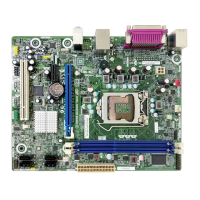Product Description
21
1.8 USB
The board supports up to six USB 2.0 ports. The port arrangement is as follows:
• Four USB 2.0 ports are implemented with stacked back panel connectors (black)
• Two USB 2.0 front panel ports are implemented through one dual-port internal
header
All six USB ports are high-speed, full-speed, and low-speed capable.
NOTE
Computer systems that have an unshielded cable attached to a USB port may not meet
FCC Class B requirements, even if no device is attached to the cable. Use a shielded
cable that meets the requirements for full-speed devices.
For information about Refer to
The location of the USB connectors on the back panel Figure 9, page 41
The location of the front panel USB headers Figure 10, page 42
1.9 SATA Interfaces
The board provides four 3 Gb/s SATA connectors, which support one device per
connector.
The underlying SATA functionality is transparent to the operating system. The SATA
controller can operate in both legacy and native modes. In legacy mode, standard IDE
I/O and IRQ resources are assigned (IRQ 14 and 15). In Native mode, standard PCI
Conventional bus resource steering is used. Native mode is the preferred mode for
configurations using the Windows* XP, Windows Vista*, and Windows 7* operating
systems.
For more information, see: http://www.serialata.org/.
For information about Refer to
The location of the SATA connectors Figure 10, page 42

